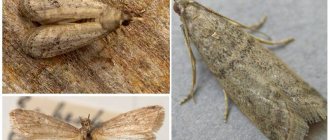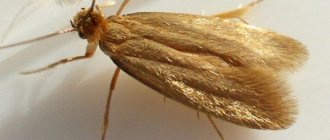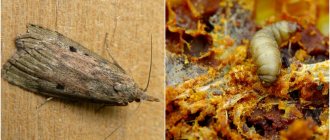Traditional methods
The undoubted advantage of old grandmother's methods is that they are harmless to the health of people and pets. You can almost always find something in the household that repels the pest and prevents it from multiplying in the apartment. Even if the required ingredient is not available, purchasing it will not cause significant damage to the family budget.
Many people have heard about orange peels, laundry soap, all kinds of essential oils and vinegar. These and other means have been tested by time.
An interesting detail: the moth was able to adapt to the action of naphthalene and practically does not react to its smell. Folk (traditional) methods and means have not lost their effectiveness.
There are two types of moths living in our apartments. You need to select herbs based on where they will be used - in the kitchen or in the wardrobe.
All plants that have a pungent odor can be divided into two groups. Some can be adjacent to food, while others cannot.
Many herbs have both medicinal properties and the ability to repel insects. They can be safely used to combat moths that have settled in the kitchen. Plants cope with this task no worse than chemical industry products.
Indoor flowers to protect against pests
All well-known folk remedies for moths are similar in that they simply repel insects, but are unable to destroy them. Since there are two types of moths, the herbs must be selected accordingly. Not everything that is used for clothing and things can be used for products.
Indoor plants are suitable for preventing the appearance of all types of moths.
Do you like indoor flowers?
Not really
Geranium
Indoor geranium.
Pelargonium or geranium is a fairly common houseplant. It is grown not only for its beauty, but also for its protective properties.
With its specific smell, the flower creates a barrier for the enemy. You can also use the leaves by placing them on the shelves of your closet.
Myrtle
The compact myrtle tree blooms beautifully and emits a lemony scent. The smell of lemon can not only scare away butterflies, but also gives things lying in the closet a pleasant aroma. It is enough to soak scraps of fabric with myrtle oil or use cotton wool rolled into a ball. Some people plant evergreen shrubs at home.
Indoor myrtle.
Lily
Indoor lily.
The indoor lily is a beautiful flower, symbolizing purity and tenderness. It has been known for a long time, even French kings decorated their coat of arms with it, and now it is widely available, and anyone has the opportunity to decorate their home with it.
By placing a pot with this plant on the windowsill, you can be sure that an enemy will not get through such reliable security. The plant repels various pests with its smell.
Plectranthus
The unusual name actually hides the usual indoor mint. An unpretentious plant with oval, drooping leaves that exude a delicate mint aroma. Plectranthus has antiparasitic properties and a pungent odor. If the leaves of this plant are spread around the apartment, their aroma will repel unwanted guests.
Indoor mint.
Tansy
This is the most famous folk remedy for all types of moths. Its specific smell forces the pest to leave its shelter. But since the plant is poisonous, it is not recommended to use it to get rid of food moths.
The flowers are especially toxic. In large quantities they are dangerous even for cattle. In small doses, tansy is used as a medicine for many diseases. Grass grows almost everywhere. Helps get rid of not only moths, but also other household pests.
Tansy reaches its greatest effectiveness during the flowering period. Plants must be dried before being placed in the closet. It is better to do this under a canopy in the fresh air.
For ease of use, flowers are made into unique bouquets. Collect 3-4 branches and tie them tightly into a broom. Hang in dressing rooms, closets and on mezzanines.
To prevent the grass from crumbling, it is placed in gauze bags. The packaging in which shoes are sold is perfect for this purpose, so there is no need to throw it away.
It is not recommended to place too many tansy in one closet. Its smell can provoke a negative reaction from the human respiratory system. Moths, unlike humans, sense even a faint aroma and strive to leave this place as soon as possible.
Dry grass should be renewed periodically. If the moth has already bred and hatched many larvae, tansy is used as an additional remedy. Measures to get rid of the pest must be carried out comprehensively.
How to get rid of moths using folk remedies
Nowadays, there are many professional means of getting rid of moths, but despite the wide selection of industrial preparations, traditional methods remain no less popular in the fight against moths in the apartment. The reasons are simple - folk recipes have many undeniable advantages when used at home:
- Safety. This is especially true if there are small children and animals in the house.
- Efficiency. If you use the recipes correctly, you can completely remove the pest from your apartment.
- Availability. Home methods include using products you already have or that are simple and inexpensive to purchase.
- Environmental friendliness. After using home recipes, you do not have to deal with the harmful consequences.
The disadvantages of using home remedies include a delayed effect: you may not see the result immediately.
Most folk remedies against moths use strong aromas.
When fighting moths, our ancestors usually used products with a pungent odor - moths cannot tolerate them. The following have stood the test of time: aromatic oils, scented soaps, aromatic plants, herbs, citrus fruits and, of course, vinegar.
Naphthalene, which may be the first product that comes to mind when thinking about moths, is now recognized as an unsafe product. Doctors have found that naphthalene is carcinogenic and causes tumors. In addition, the moth gradually developed an addiction to the drug, and now most populations are resistant to naphthalene.
Essential oils
A pleasant, well-proven product. A small amount is enough so that the voracious insect no longer appears in the room where moths are suspected.
In addition to repelling moths, essential oils have many beneficial properties, including a healing effect.
Moths react most intensely to lavender, fir, eucalyptus, rosemary, patchouli, citronella and lemongrass oils. Choose the most pleasant aroma from them so that you feel comfortable while fighting the pest. Just do not pour the product directly onto fabric or wardrobe items - stains may appear. It’s better to drop it on a cotton pad, a small piece of paper, or even just a paper napkin, and distribute it around the room, in places that might be of interest to moths.
Herbs
If you have easy access to plants such as wormwood, tansy, mint, eucalyptus, cloves or nuts, then you can assume that the moth problem has been solved. From trees, fresh leaves and pieces of bark are used; the grass is collected during the flowering period. Plants need to be dried, tied into small bunches and placed on cabinet shelves.
It is better to collect fragrant herbs at the time of flowering, just before ripening.
To prevent grass particles from remaining on the fabric, you can use small bags, for example, tea bags, or simply wrap them loosely in a napkin. The main thing is that the aroma passes through unhindered.
When using dry herbs to fight moths, it is important not to forget to check whether the smell has worn out. If the aroma has weakened so much that it is no longer felt, the product needs to be updated.
Citrus peels
The peel of any citrus fruit (oranges, tangerines, lemons, limes and others) is good in the fight against moths, both fresh and dried. Our grandmothers saw tangerines with oranges mainly on New Year's Eve, but they never threw away the peels. They were dried and then put away from pests in kitchen cabinets and on shelves with clothes.
To repel moths, the peel must be fresh
Surprisingly, unlike many chemicals, moths have not developed an addiction to the pleasant aroma of citrus fruits, so 2-3 crusts on the shelf can scare away harmful butterflies from it for a long time. You just have to keep in mind that fresh peels, unlike dried zest, can go bad.
Fresh citrus peels on cabinet shelves should be changed before they show signs of drying, and mold should not be allowed to form.
Herbs and spices
Moths also cannot tolerate the aroma of herbs and spices. Bay leaf, pepper, thyme, coriander, curry, cinnamon, cloves, saffron, cardamom and even vanilla - anything that has a pungent odor repels moths and prevents breeding. Moths will not be able to lay eggs on shelves where these specific aromas are present.
Fragrant powders can be poured into small open containers
It is especially convenient to use spices and spices in the kitchen, where their aroma will only improve the atmosphere of the room. Bulk spices can be placed in places where pests accumulate directly in a special packaging, slightly unscrewing the lid so that the smell spreads better. Larger spices, such as vanilla or cinnamon sticks, as well as large peppers, can simply be laid out loosely on the shelves.
Laundry soap
The method is universal, but due to the unpleasant smell it is used mainly for non-residential premises such as storage rooms and closets. To drive away moths using laundry soap, you can prepare a soap solution and wash the inside surfaces of the cabinets with it, or you can cut the bar into pieces and place it in places where pests accumulate. For example, in furniture, on the shelves of closets and cabinets, or in the pockets of clothes that you want to protect.
Fresh laundry soap will repel moths more effectively
The effect of laundry soap is also effective against moth larvae - it seriously limits their movement.
Tobacco or shag
This remedy should also not be abused when saving clothes from moths. It is better to use dry tobacco where the smell will only harm moths - inside furniture or in non-residential premises.
When using tobacco, it is important to ensure that the smell does not spread to clothing and living areas.
The method of application is similar to the use of herbs and spices: the dried mixture is put into bags with holes and placed in places where moths may appear. A good result is achieved by adding a few peas of black pepper per bag to the tobacco.
Tobacco and shag are effective against moths, but only in their natural form. Once shaken out of cigarettes, tobacco is useless.
Vinegar
Thanks to its pungent odor, vinegar has become one of the most effective folk remedies against moths. In the old days, housewives heated cast iron containers to high temperatures and poured this caustic agent into the bottom. The vinegar began to evaporate, and then the container was brought to the places where the moths appeared to saturate them with vapor. Nowadays, housewives add vinegar to the water when cleaning, which also perfectly repels moths. A few tablespoons of product per bucket of water is enough.
When using vinegar, you need to remember safety rules
Garlic
But garlic, like mothballs, has not stood the test of time. True, not at all because of the harmful effects on humans and animals. Among popular advice you can find references to the fact that the pungent smell of garlic supposedly repels moths, but this is a very dubious statement.
Most moth species are resistant to garlic
The fact is that the long-term use of garlic against all kinds of insects has become addictive, and now many types of pests not only do not react to the smell, but also happily feed on this useful plant.
When using folk remedies against moths, it is worth remembering that most of them are based on repelling insects with the help of pungent odors. Before using the chosen method, make sure that family members are not allergic to it.
Photo gallery: additional methods of pest control
Camphor can repel moths from closets with clothes or food for a long time: just apply 1-2 drops to cotton pads or scraps of fabric and place them in places where the pest appears
It is necessary to scatter the powder throughout the contaminated room approximately every 1.5–2 meters, but it must be taken into account that the total consumption per apartment should be limited to a few grams of dry matter
The fruits of the plant do not have a strong odor, but moths still cannot tolerate them: you need to dry the chestnuts in the oven to prevent spoilage and place them on shelves
Geranium itself is a living repellent; one plant per room is enough to prevent the pest from appearing.
Fragrant tobacco will protect the room from the invasion of moths, just water the flower in time, enjoy the beautiful flowering, and at the same time the absence of moths
Artemisia grass
Moths do not like the bitter smell just like the aroma of tansy. If you smell the plant, you will feel a peculiar taste in your mouth. In large quantities, wormwood can cause reactions such as dizziness and severe headaches.
To successfully fight moths in an apartment, it is enough to place several sprigs of dried wormwood in the closet. They will not cause any harm to health, but will drive away insects.
Under the influence of the aroma of grass, butterflies lose orientation in space and cannot lay eggs. Wormwood is used as a preventative and control measure. It is better not to use it in the kitchen against food moths.
Wormwood essential oil has the greatest effect. It drives moths out of the closet. Its vapors kill bacteria that are harmful to health.
It is useful to keep pads soaked in wormwood oil in a drawer or bag with socks. This will protect them from moths and help eliminate the problem of unpleasant foot odor.
Benefits of folk remedies against moths
Many housewives believe that it is easier to prevent the gray guest from entering the house by placing dry plants in the closets that emit a pungent odor (wormwood, lavender, geranium, cloves, walnut branches). If a white, inconspicuous butterfly flies around the house, then it is better to use folk remedies. They have advantages over chemicals:
- do not contain toxic components and insecticides, therefore, when treating cabinets and mezzanines, household members do not have to leave the rooms;
- the costs of removing the uninvited guest will be small;
- you don’t need to go to specialized stores to buy folk remedies (just go out into the garden or look at the kitchen shelf: every home has many components that will be effective in fighting moths);
- home remedies are highly environmentally friendly; humans do not experience any side effects from their use.
All remedies against gray moths have one drawback: their action is long-lasting, and the result is not immediately visible.
Interesting to know! About thirty species of moths are known. The moths flying around the house are males and do not cause any harm. Females that lay eggs hide in secluded places. It is necessary to fight them, otherwise the eggs will hatch into larvae, and then caterpillars, which will begin to take over the mezzanines and kitchen tables.
Lavender
The subtle smell found in the aromas of many cosmetics and perfumes is very unpleasant to moths. This feature of the plant is used in the development and manufacture of industrial products. Buy lavender-based essential oil at the pharmacy, soak napkins in it and place it on the shelves with your laundry.
In a closet with outerwear, “lavender” scraps are tied in a knot on a crossbar or placed in the pockets of fur coats and sheepskin coats. The good thing about this method is that the clothes removed from the wardrobe do not emit a chemical aroma, but smell quite pleasant.
Applications of lavender flowers:
- Dry plants are laid out in the depths of the shelves (3-4 branches are enough for each).
- As the aroma wears off, the flowers change.
- The supply should be kept in a tightly closed container. It is better if it is glassware.
When sending warm blankets for summer storage, dry them in the sun and put them in bags with lavender sprigs. In sealed packaging, the aroma lasts much longer than on cabinet shelves, so dried flowers do not need to be changed.
What are moths afraid of in the apartment?
Many products can kill parasites living in the home. But you can use ordinary means at hand, the smell of which repels clothing, potato and other insects. This folk method is relevant because it does not harm the health of people and animals.
Various plants and substances can become a means of prevention, through which you can build reliable protection against pests at home. It is worth knowing the list of these odors in order to use them in your home - house or apartment.
What smells are moths and their larvae afraid of?
A product category of insect or even larvae, from which a small butterfly has not yet formed, enters the closet. She is afraid of the smell of orange peels, because the strong aroma that this product emits can repel all parasites. Any citrus fruit, including tangerines and lemon, can be used as a means to get rid of the larvae. Fresh crusts need to be placed where the pest lives, and constantly replaced with new ones.
If a closet or an entire apartment has become a habitat for potato or clothing insects, you can also lay out pieces of laundry soap. This smell is not pleasant to people, so it is rarely used in the closet. The clothing larva is eliminated due to more delicious aromas. For example, there are plants that moths are afraid of: lavender, tobacco, geranium and others. Dry or fresh herbs are placed indoors so that the plant emits its aroma everywhere. Lavender herb can be used as an oil, which is sold in pharmacies and stores. Lavender effectively repels insects and has a gentle taste for humans.
What essential oil is moth afraid of?
At home, you can use essential oils that have a powerful scent to get rid of moths. This could be mint or eucalyptus oil, which you simply need to apply in large quantities to the surface. The folk method will not only help you fight pests, but also ensure that your apartment has a pleasant aroma.
What are kitchen moths afraid of and how to get rid of them?
The kitchen larva is afraid of similar folk remedies. She also finds the strong smell of vinegar or garlic unpleasant. The herbs often used are cloves, tansy, wormwood, valerian and chamomile.
The kitchen is a place where various products and kitchen utensils are located, so it is important to repel insects only with safe means. Plants and substances from folk methods can become such
Mint
This herb is versatile. It is used not only in the wardrobe, but also in the kitchen. The smell is pleasant, it has a beneficial effect on the human nervous system and calms. For moths, the scent of mint is a signal to leave the apartment.
If you have a summer cottage, you can grow mint there. In the pharmacy it is sold already in dried form, although recently picked plants work better.
Mint grows well in indoor pots. You just need to get hold of rhizomes for planting. You can not only forget about moths, but also drink aromatic tea with fresh leaves.
If the butterfly has already laid eggs, then mint alone is unlikely to help. To combat larvae, you need to add tansy or wormwood to the bouquet.
It is useless to fight against food moths by laying out grass on shelves. First you need to get rid of contaminated products, clean the cabinets and only then place mint sprigs next to the cereals.
Since the larvae left the house along with the garbage, the eggs were washed off with a rag, all that remains is to get rid of the butterflies. The mint flavor will cope with this very quickly. In just a few days you will not see a single moth flying around the kitchen.
How plants repel insects
Plants contain organic compounds - essential oils. They are found in various parts: leaves, flowers, roots, fruits and seeds. For effective pest control, use those parts that contain the most essential substances.
Many people are interested in how a moth will sense the smell of a referent if its source is hidden in a closed cabinet. According to microbiological research, the pest butterfly is able to sense a minimal amount of odor at a distance of 1 mile. She can easily smell an unpleasant substance behind the cabinet doors.
You should not be afraid that moths will not be able to scare off repellents, the smell of which a person cannot smell. Pests will not fly into the room where horse chestnuts are laid out, although their smell is not noticeable to people.
The essential scent does not kill moth eggs and larvae, but only repels adult insects. Odoriferous substances are used for prevention, not to kill pests.
Therefore, it is necessary to take precautions when storing food and clothing:
Only clean items that are pre-treated with chemical insecticides or essential oils are placed in wardrobes. The smell of unwashed clothes attracts pests; moth larvae readily eat contaminated parts. Bulk products in which moths infest are stored in tightly sealed containers. Do not allow food to get wet, as pest larvae prefer a moist environment. What herbs repel moths
Repellent plants that effectively drive away moths are grown on the windowsills of kitchens and apartments. A butterfly that smells them will fly around these rooms.
Wormwood
It lives in the wild, but many species are grown on balconies, terraces and loggias. Indoor varieties of wormwood have been bred, which are distinguished by their spectacular silver color and beautiful leaf shape. They have the beneficial properties of wild wormwood, but grow year-round.
This plant can be called a champion in repelling household pests. Its specific aroma drives away moths, cockroaches, fleas and other parasites. To control pests, use wormwood branches, dried in a dark and ventilated place. They are placed on the shelves of cabinets and pantries.
To prevent the plants from falling off, crushed dry wormwood is placed in a sachet. They are hung in closets, placed in the pockets of fur jackets, coats and fur coats, and placed in bags with woolen products.
Oregano
This plant has another name - oregano. It has long been used to repel moths and other domestic insects. Oregano is popularly called bedbug grass or flea grass, which indicates its insecticidal properties, useful in the fight against parasites.
There are indoor varieties of oregano that have an attractive appearance, pleasant taste and aroma. They are used as spices in dishes, added to pickles and preparations.
Chamomile
Bright, elegant inflorescences of Dalmatian chamomile (pyrethrum) are found in flower beds, borders and ridges. Low-growing varieties are grown on balconies, loggias and in rooms. This plant has long been used to control insects. Crushed pyrethrum flowers are used for the industrial production of insecticidal powders.
The smell of chamomile is unbearable for butterflies and moth larvae. To preserve woolen items, insecticidal powders are added to the rinse water. Sachets with fragrant pyrethrum are placed in wardrobes.
Rosemary
Fragrant bushes are grown not only in the country, but also at home. The plant is used as a spice, adding a special taste to dishes and preparations. The smell of rosemary is not tolerated by moths. Fresh or dried branches of the plant are placed on the shelves of wardrobes and kitchen cabinets, and placed on furniture. The essential aroma is exhausted, so the branches are often renewed.
Lavender
This plant with delicate purple flowers and a wonderful aroma is grown not only in flower beds, but also at home, in flower pots. Dried lavender inflorescences retain a specific smell.
To repel moths, use fresh and dry parts of the plant, which are placed in cabinets and in the kitchen. Dried flowers are sprinkled onto linens for scent and placed in sachets for hanging on hangers. A decoction is prepared from lavender, which is used to wash kitchen cabinets, and dry herbs are scattered in the corners.
Mint
This aromatic herb is grown at home in a flower pot. Its smell repels insects, purifies the air and refreshes it. Mint has a beneficial effect on the nervous system, improves the microclimate in the house and makes it comfortable.
Other herbs
All folk (natural) remedies for moths are based on the use of odors that this insect is afraid of.
Can be used:
- sweet clover;
- chestnuts (leaves and fruits);
- yarrow;
- sage.
Some housewives make bouquets of them.
For this:
- Take a tansy branch and put wormwood on it.
- Then sweet clover, and even lower - sage.
- The bouquet is tied with an elastic band and the excess is cut off.
- Already in this form, the broom can be hung in the closet. There it will dry.
Dense wreaths are woven from fresh flowers and grass that protects against moths and dried in this form.
How to properly use plants against moths
Not only the plants listed above have an anti-moth effect, but also the essential oils extracted from them. A few drops of this composition are dissolved in water and the inside surface of kitchen cabinets is wiped with the solution. Rags and cotton pads, moistened with oil, are laid out in cabinets and placed in the interior of the furniture. The following essential oils repel moths:
- geraniums;
- wormwood;
- rosemary;
- mint;
- lemon;
- myrtle.
It should be remembered that plants will not help where there are a lot of pests and their larvae. In this case, insect repellent chemicals are used for extermination. The following rules will help you achieve maximum effect from using anti-moth flowers and essential oils:
- Dry and fresh plants are used immediately after butterflies are noticed. Larvae should not be allowed to multiply and the home may become heavily infested with pests.
- To prevent moths from becoming accustomed to a particular product, anti-moth plants are regularly changed.
- The twigs and sachets retain their scent for 2-3 months, then they are replaced with new ones.
- To enhance the anti-moth effect, collections of fragrant plants are used.
Newspapers
Moths cannot stand the smell of printing ink. Our grandmothers covered the shelves of cupboards and wardrobes with newspapers. To protect your favorite fur coat from damage, you can remember the old folk method and put several crumpled newspapers in a case with outerwear.
To achieve the greatest effect, the press must be fresh. When storing winter boots in your closet, stuff your boots and boots tightly with crumpled up newspaper. In this way, two problems are solved: the shoes retain their shape, and moths will never appear in them.











